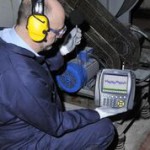
Early bearing failure detection reduces machine downtime
Published: 14 June, 2019
Condition monitoring is the best way to detect developing bearing problems before they become the cause of costly production machinery failures, says Phil Burge, marketing and communications manager at SKF.
Read any study into the consequences of unplanned machinery downtime for manufacturers and you will be confronted by a variety of statistics - mostly relating to the stratospheric financial penalties incurred as a result of lost production and often quoted in the region of ‘tens of billions of dollars’ annually. Indeed, one recent study by a prominent UK-based field service management specialist in collaboration with a cohort of British manufacturers has estimated the cost of unplanned machine downtime to UK industry as a whole at more than £180 billion per annum.
A well planned routine maintenance program will, of course, help prevent many unscheduled stoppages; however, machine health can be difficult to diagnose between maintenance intervals and additional tools may be required to detect a developing fault before it results in machinery malfunction and ultimate failure. The eyes and ears of a competent machine operator will always provide that first line of defence, but, there is really only one option that guarantees 24/7 round-the-clock appraisal of machine health: machine condition monitoring; and there is no better place to start than at the bearings which support so many machine functions.
Happily, around 90% of bearings outlive the equipment in which they are installed. An estimated 9.5% are replaced in service, leaving a mere 0.5% that actually fail in service - usually because they are poorly lubricated, subject to excessive contamination or even as the result of inadequate installation procedures.
Condition monitoring - particularly vibration monitoring - is effective at detecting the earliest stage of bearing failure, which may not be immediately apparent to an observer. A technique called acceleration enveloping – a signal processing method that filters out unwanted noise from other machine components – will speed up this important first-stage detection process. If more serious damage occurs - raceway spalling, for example - the bearing is likely to become noisy and there will be an increase in its operating temperature, which a competent machine operator is likely to spot. Beyond this stage, and if signs of damage are still undetected, the bearing may suffer fatigue fracture of its inner ring leading to catastrophic failure and possible damage to neighbouring machine components.
Bearing problems usually present themselves from five common ‘symptoms’: noise; vibration; heat; shaft movement; and frictional moment to rotate the shaft. A higher than normal temperature, for example, could be due to under- or over-lubrication, but could equally be caused by seal problems (excessive tightness, or incorrect orientation), insufficient clearance or improper bearing loading.
Bearings in good condition produce a ‘purring’ sound, while those in a deteriorating condition making grinding, squeaking noises. Vibration monitoring is an effective way to identify deterioration or damage in a bearing because developing mechanical problems are usually accompanied by an increase in vibration. Moreover, the nature of the fault can be determined by analysing the vibration characteristics or ‘signature’.
Monitoring temperature can also help to spot early signs of damage. If the temperature of the bearing housing rises above what might be expected during normal operating conditions this may be an indication of imminent bearing damage. However, a natural temperature rise – lasting a day or two – commonly occurs immediately after first machine start up, and after each grease re-lubrication.
Keeping on top of lubrication is a highly effective way of preventing bearing damage as poor lubrication - using the wrong lubricant, incorrect dosing, or re-lubricating at the wrong intervals - is the commonest cause of bearing failure. In addition to following correct lubrication procedures, check frequently for leaks in the vicinity of bearings; keep protective collars and labyrinth seals filled with grease for maximum protection; if installed, check that automatic lubrication systems are working properly, and check lubricant levels in sumps and reservoirs, keeping them topped up as necessary. Periodic analysis of lubricant samples taken from bearings in service is also advisable.
Early identification of developing bearing faults is clearly advantageous, but should the problem persist it will be necessary to determine the underlying problem and apply a permanent fix. Condition monitoring detects problems early on, but cannot fully diagnose them and for this, a failing bearing must be removed for visual inspection of its component parts. This is usually carried out in accordance with the international standard ISO 15243:2004, which categorises six main damage/failure modes (fatigue; wear; corrosion; electrical erosion; plastic deformation; and fracture/cracking), broken into 14 sub-categories. This will pinpoint the cause of failure and suggest remedial action to avoid reoccurrence.
Bearing failure is inevitable, as factors such as lubrication and installation are never perfect. Condition monitoring techniques that track bearing vibration, temperature and noise help to ensure that bearings fall into the ‘replaced in service’ rather than the ‘failed in service’ category.






